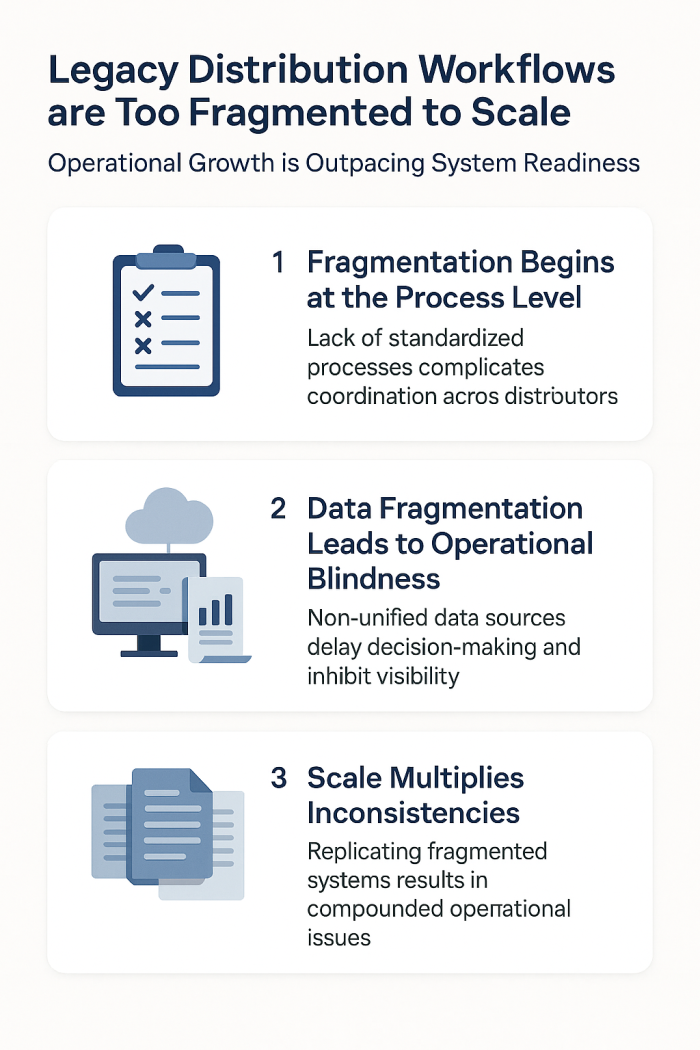Operational Growth is Outpacing System Readiness
As FMCG, Pharmacy, and Tobacco companies scale their operations across multiple geographies and distributor networks, they face a hard truth: their legacy distribution workflows were never built for this level of complexity. What once worked when dealing with a few regional distributors now buckles under the weight of national expansion, cross-channel strategies, and real-time data demands.
Processes that rely on manual reconciliation, siloed spreadsheets, or distributor-specific practices introduce inefficiencies that worsen with scale. Instead of accelerating growth, these fragmented workflows create delays, errors, and operational blind spots—slowing the business when it should be gaining momentum.
Fragmentation Begins at the Process Level
Much of the inefficiency stems from the lack of standardized processes across the distribution chain. Each distributor may have its own method for handling sales orders, managing inventory, processing returns, or submitting trade promotion claims. While these practices may serve local needs, they make central coordination nearly impossible.
This process fragmentation means that principals or head offices cannot compare performance accurately, detect anomalies early, or enforce consistent commercial policies. Each new market expansion requires custom onboarding, data mapping, and training—draining resources that could be used to innovate or deepen market penetration.
Data Fragmentation Leads to Operational Blindness
Beyond processes, data itself is fragmented. Sales, inventory, claim, and coverage data often reside in different systems—some cloud-based, some desktop-based, some still paper-based. There is no single source of truth, no real-time visibility, and no way to trust that decisions are being made on accurate, consistent insights.
This lack of data cohesion delays decision-making. Promotions are launched without full awareness of inventory constraints. Sales strategies are built on lagging indicators rather than predictive signals. And by the time consolidated reports reach leadership, the opportunity to act may have already passed.
Scale Multiplies Inconsistencies
When fragmented systems and workflows are replicated across dozens—or even hundreds—of distributor partners, the inconsistencies compound. Some distributors submit sales data daily, others weekly. Some follow pricing approvals rigorously; others skip steps due to manual overload. As a result, principals lose control not just of operations, but of their brand consistency in the market.
Worse, scaling under these conditions often means throwing more people at the problem. Teams are hired to chase data, clean reports, manage exceptions, and reconcile discrepancies. But these efforts do not scale sustainably. They mask the symptoms rather than fix the root cause: fragmentation.
Change Becomes a Project, Not a Capability
In fragmented environments, even minor changes—like a price update, new promotion rule, or product launch—become large-scale coordination efforts. Multiple stakeholders must be informed manually. System updates require custom scripting or workarounds. Field teams operate with outdated information while waiting for back-end alignment.
This reduces organizational agility. Instead of adapting quickly to market shifts, companies become bogged down by internal coordination. In fast-moving sectors, that delay can mean lost shelf space, missed revenue, or brand damage.

Legacy Systems Were Built for Simplicity, Not Scale
The technology that underpins legacy workflows was typically built for basic transaction tracking—order in, invoice out. It wasn’t designed to support dynamic pricing, promotion planning, mobile-first field execution, or predictive analytics. As customer expectations evolve and channel complexity increases, these systems become liabilities.
Companies that continue to patch old systems rather than reimagine their workflows risk falling further behind. Their competitors, equipped with integrated platforms and intelligent process engines, can move faster, make smarter decisions, and deliver a more consistent customer experience.
Scalability Requires a Process-First Redesign
Solving fragmentation doesn’t start with systems—it starts with process clarity. Organizations must map their end-to-end distribution workflows, identify redundancies and exceptions, and then design scalable, digital-first processes that work across all distributors and regions. Technology should support the process—not the other way around.
Once this foundation is set, automation and integration become significantly easier. Approval workflows can be embedded, real-time dashboards can be activated, and new distributors can be onboarded without massive customization.
Conclusion: You Can’t Scale Chaos
Legacy workflows may have brought companies this far, but they cannot carry them forward. As organizations aim for scale, speed, and sustainability, fragmented systems and disconnected processes stand in the way. The future of distribution belongs to those who simplify, standardize, and synchronize.
Scaling isn’t just about growing revenue—it’s about growing operational intelligence. And that begins by unifying how work gets done.
